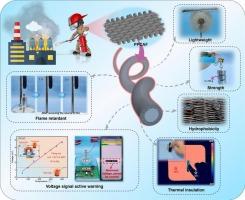基于护套芯结构的聚酰亚胺多孔热电纤维:一种用于火灾预警和阻燃保护的新型自供电材料
IF 13.2
1区 工程技术
Q1 ENGINEERING, CHEMICAL
引用次数: 0
摘要
在火灾易发环境中实现预警和热防护功能的集成,仍然是智能防护纺织材料发展的一个重大挑战。本研究提出了一种结构调控策略,利用碳纳米管(CNT)和Ag2Se纳米棒的协同模板效应和应力取向效应,成功构建了具有稳定鞘核结构的聚酰亚胺(PI)/预氧化聚丙烯腈(panof)/CNT/Ag2Se复合多孔纤维(PPCAF)。核心由致密的板/CNT/Ag2Se(s)相组成,提供热响应性和机械支撑。外壳包含多孔PI矩阵,可以缓冲应力,隔热,防止Ag2Se降解和脱落,从而提高热转换和信号稳定性。这种合理的结构使光纤能够快速响应火灾引起的热刺激,通过塞贝克效应在1.8 秒内实现4.5 mV的最大热电电压,确保稳定的自供电火灾警报。同时,该纤维具有优异的被动防护性能,包括高抗拉强度(18.93 MPa)、阻燃性(LOI: 55.6% %)、低导热系数(0.0298 W/m·K)和超疏水性(接触角:160.2°)。这些综合性能有助于减缓火焰蔓延,最大限度地减少热量传递,并阻止水分侵入。本研究为设计具有双重防火功能的先进自供电智能纺织材料提供了理论见解和实践指导。本文章由计算机程序翻译,如有差异,请以英文原文为准。

Polyimide porous thermoelectric fibers based on sheath core structure: A new self-powered material for early fire warning and flame retardant protection
The integration of early warning and thermal protection functions in fire-prone environments remains a significant challenge in the development of intelligent protective textile materials. In this study, a structural regulation strategy is proposed, leveraging the synergistic templating and stress-orientation effects of carbon nanotubes (CNT) and Ag2Se nanorods to successfully construct a polyimide (PI)/pre-oxidized polyacrylonitrile (panof)/CNT/Ag2Se composite porous fiber (PPCAF) featuring a stable sheath–core architecture. The core, composed of a dense panof/CNT/Ag2Se(s) phase, offers thermal responsiveness and mechanical support. The shell comprises a porous PI matrix that buffers stress, insulates heat, and prevents Ag2Se degradation and shedding, thereby enhancing thermal conversion and signal stability. This rational architecture enables the fiber to rapidly respond to fire-induced thermal stimuli, achieving a maximum thermoelectric voltage of 4.5 mV within 1.8 s via the Seebeck effect, ensuring stable self-powered fire warning. Concurrently, the fiber exhibits excellent passive protection, including high tensile strength (18.93 MPa), flame retardancy (LOI: 55.6 %), low thermal conductivity (0.0298 W/m·K), and superhydrophobicity (contact angle: 160.2°). These integrated properties contribute to slowing flame spread, minimizing heat transfer, and blocking moisture intrusion. This study provides both theoretical insights and practical guidelines for designing advanced self-powered intelligent textile materials with dual fire protection functionalities.
求助全文
通过发布文献求助,成功后即可免费获取论文全文。
去求助
来源期刊

Chemical Engineering Journal
工程技术-工程:化工
CiteScore
21.70
自引率
9.30%
发文量
6781
审稿时长
2.4 months
期刊介绍:
The Chemical Engineering Journal is an international research journal that invites contributions of original and novel fundamental research. It aims to provide an international platform for presenting original fundamental research, interpretative reviews, and discussions on new developments in chemical engineering. The journal welcomes papers that describe novel theory and its practical application, as well as those that demonstrate the transfer of techniques from other disciplines. It also welcomes reports on carefully conducted experimental work that is soundly interpreted. The main focus of the journal is on original and rigorous research results that have broad significance. The Catalysis section within the Chemical Engineering Journal focuses specifically on Experimental and Theoretical studies in the fields of heterogeneous catalysis, molecular catalysis, and biocatalysis. These studies have industrial impact on various sectors such as chemicals, energy, materials, foods, healthcare, and environmental protection.
 求助内容:
求助内容: 应助结果提醒方式:
应助结果提醒方式:


